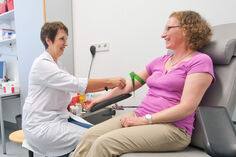AG Biochemistry of Metabolic Adaptability
Dysregulation of energy homeostasis is hallmark of various metabolic diseases such as diabetes. The chronic metabolic imbalances which occur in diabetes, in particular type-2-diabetes (T2D), puts those individuals diagnosed with the disease at significant risk for long-term vascular complications, which include macrovascular (cardiovascular comorbidities) and microvascular (nephropathy, retinopathy and neuropathy) complications. Unfortunately, current treatment options for T2D are limited and are relatively ineffective with respect to complications. However, recent advances from large cohort studies have established subtypes of T2D, that predict the risk for diabetes complications. Of the five novel subgroups which have been identified, one has been found to account for 20% of patients with T2D and has been shown to have a rapid progression of diabetes-related complications and is referred to as severe insulin-resistant diabetes (SIRD). SIRD is characterized by high insulin resistance of skeletal muscle, liver and adipose tissue leading to ectopic fat deposition in the liver and other tissues, thereby driving changes in mitochondrial function and the loss of energy homeostasis. Despite such findings, the question remains whether such changes are the cause or consequence of T2D and the associated complications.
The focus of this research group is to characterize the metabolic imbalances that occur between the adipose tissue, skeletal muscle and liver in diabetes, specifically in those individuals with high-risk SIRD subtype. By determining the metabolic imbalances in these tissues, as well as the relationship between them, we seek to understand the mechanisms leading to the development and progression of diabetic complications. In particular we are interested in the role of reactive metabolites, by-products of energy metabolism which include reactive oxygen species (ROS), reactive nitrogen species (RNS) and reactive carbonyl species (RCS).
In order to achieve these aims, we take a patient-focused approach. This involves the collection and analysis of tissue biopsies taken from individuals, recruited by our clinical research centre, and who have undergone extensive clinical and metabolic phenotyping as part of on-going longitudinal observational studies. With expertise in the functional analysis of metabolism (using high-resolution respirometry and the seahorse bioanalyzer), biochemical and metabolite analysis (by isotope dilution, liquid chromatography, tandem mass spectrometry), as well as advanced molecular biology techniques, such as proteomics and transcriptomics, we are able to perform an in-depth characterization of the metabolic changes occurring in the tissues from those individuals at high-risk of diabetic complications. In doing so, we seek to understand the molecular and biochemical mechanisms responsible for the changes observed in energy homeostasis and provide novel therapeutic strategies for correcting these detrimental imbalances.
Ausgewählte Publikationen
- Al-Saoudi E, Christensen MMB, Nawroth P, Fleming T, Hommel EE, Jørgensen ME, Fleischer J, Hansen CS. Advanced glycation end-products are associated with diabetic neuropathy in young adults with type 1 diabetes. Front Endocrinol (Lausanne). 2022 Oct 11;13:891442. doi: 10.3389/fendo.2022.891442. PMID: 36303871; PMCID: PMC9592972.
- Sulaj A, Kopf S, von Rauchhaupt E, Kliemank E, Brune M, Kender Z, Bartl H, Cortizo FG, Klepac K, Han Z, Kumar V, Longo V, Teleman A, Okun JG, Morgenstern J, Fleming T, Szendroedi J, Herzig S, Nawroth PP. Six-Month Periodic Fasting in Patients With Type 2 Diabetes and Diabetic Nephropathy: A Proof-of-Concept Study. J Clin Endocrinol Metab. 2022 Jul 14;107(8):2167-2181. doi: 10.1210/clinem/dgac197. PMID: 35661214; PMCID: PMC9282263.
- Weis EM, Puchalska P, Nelson AB, Taylor J, Moll I, Hasan SS, Dewenter M, Hagenmüller M, Fleming T, Poschet G, Hotz-Wagenblatt A, Backs J, Crawford PA, Fischer A. Ketone body oxidation increases cardiac endothelial cell proliferation. EMBO Mol Med. 2022 Apr 7;14(4):e14753. doi: 10.15252/emmm.202114753. Epub 2022 Feb 18. PMID: 35179309; PMCID: PMC8988203.
- Gancheva S, Kahl S, Pesta D, Mastrototaro L, Dewidar B, Strassburger K, Sabah E, Esposito I, Weiß J, Sarabhai T, Wolkersdorfer M, Fleming T, Nawroth P, Zimmermann M, Reichert AS, Schlensak M, Roden M. Impaired Hepatic Mitochondrial Capacity in Nonalcoholic Steatohepatitis Associated With Type 2 Diabetes. Diabetes Care. 2022 Apr 1;45(4):928-937. doi: 10.2337/dc21-1758. PMID: 35113139.
- Morgenstern J, Groener JB, Jende JME, Kurz FT, Strom A, Göpfert J, Kender Z, Le Marois M, Brune M, Kuner R, Herzig S, Roden M, Ziegler D, Bendszus M, Szendroedi J, Nawroth P, Kopf S, Fleming T. Neuron-specific biomarkers predict hypo- and hyperalgesia in individuals with diabetic peripheral neuropathy. Diabetologia. 2021 Dec;64(12):2843-2855. doi: 10.1007/s00125-021-05557-6. Epub 2021 Sep 3. Erratum in: Diabetologia. 2021 Oct 11; PMID: 34480211; PMCID: PMC8563617.
- Tsokanos FF, Muley C, Khani S, Hass D, Fleming T, Wolff G, Bartelt A, Nawroth P, Herzig S. Methylglyoxal Drives a Distinct, Nonclassical Macrophage Activation Status. Thromb Haemost. 2021 Nov;121(11):1464-1475. doi: 10.1055/s-0041-1726346. Epub 2021 May 9. PMID: 33966256.
- Chen J, Fleming T, Katz S, Dewenter M, Hofmann K, Saadatmand A, Kronlage M, Werner MP, Pokrandt B, Schreiter F, Lin J, Katz D, Morgenstern J, Elwakiel A, Sinn P, Gröne HJ, Hammes HP, Nawroth PP, Isermann B, Sticht C, Brügger B, Katus HA, Hagenmueller M, Backs J. CaM Kinase II-δ Is Required for Diabetic Hyperglycemia and Retinopathy but Not Nephropathy. Diabetes. 2021 Feb;70(2):616-626. doi: 10.2337/db19-0659. Epub 2020 Nov 25. PMID: 33239449.
- Deshpande D, Agarwal N, Fleming T, Gaveriaux-Ruff C, Klose CSN, Tappe-Theodor A, Kuner R, Nawroth P. Loss of POMC-mediated antinociception contributes to painful diabetic neuropathy. Nat Commun. 2021 Jan 18;12(1):426. doi: 10.1038/s41467-020-20677-0. Erratum in: Nat Commun. 2021 Feb 8;12(1):989. PMID: 33462216; PMCID: PMC7814083.
- Strom A, Strassburger K, Schmuck M, Shevalye H, Davidson E, Zivehe F, Bönhof G, Reimer R, Belgardt BF, Fleming T, Biermann B, Burkart V, Müssig K, Szendroedi J, Yorek MA, Fritsche E, Nawroth PP, Roden M, Ziegler D; GDS Group. Interaction between magnesium and methylglyoxal in diabetic polyneuropathy and neuronal models. Mol Metab. 2021 Jan;43:101114. doi: 10.1016/j.molmet.2020.101114. Epub 2020 Nov 6. PMID: 33166742; PMCID: PMC7704399.
- Morgenstern J, Campos Campos M, Nawroth P, Fleming T. The Glyoxalase System-New Insights into an Ancient Metabolism. Antioxidants (Basel). 2020 Oct 1;9(10):939. doi: 10.3390/antiox9100939. PMID: 33019494; PMCID: PMC7600140.
- Morgenstern J, Katz S, Krebs-Haupenthal J, Chen J, Saadatmand A, Cortizo FG, Moraru A, Zemva J, Campos MC, Teleman A, Backs J, Nawroth P, Fleming T. Phosphorylation of T107 by CamKIIδ Regulates the Detoxification Efficiency and Proteomic Integrity of Glyoxalase 1. Cell Rep. 2020 Sep 22;32(12):108160. doi: 10.1016/j.celrep.2020.108160. PMID: 32966793.
- Brings S, Fleming T, Herzig S, Nawroth PP, Kopf S. Urinary cathepsin L is predictive of changes in albuminuria and correlates with glucosepane in patients with type 2 diabetes in a closed-cohort study. J Diabetes Complications. 2020 Sep;34(9):107648. doi: 10.1016/j.jdiacomp.2020.107648. Epub 2020 Jun 2. PMID: 32532588.
- Schwarz D, Hidmark AS, Sturm V, Fischer M, Milford D, Hausser I, Sahm F, Breckwoldt MO, Agarwal N, Kuner R, Bendszus M, Nawroth PP, Heiland S, Fleming T. Characterization of experimental diabetic neuropathy using multicontrast magnetic resonance neurography at ultra high field strength. Sci Rep. 2020 May 5;10(1):7593. doi: 10.1038/s41598-020-64585-1. PMID: 32371885; PMCID: PMC7200726.






